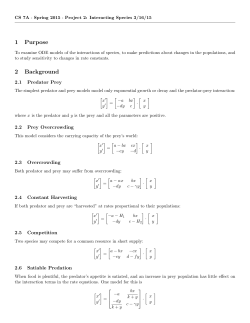
bifurcation and continuation of halo orbits - rigorous
BIFURCATION AND CONTINUATION OF HALO ORBITS - RIGOROUS NUMERICAL APPROACH Irmina Walawska1, Daniel Wilczak1 Faculty of Mathematics and Computer Science Jagiellonian University Lojasiewicza 6, 30-348 Krak´ow, Poland Keywords: Halo orbits, three body problem, bifurcations, rigorous numerical analysis Introduction The Restricted Three Body Problem is a model equation for motion of a massless particle in the gravitational force of two large primaries. It attracts attention of many researches also because of its applicability to space missions, for instance the Genesis mission. Main results The system is given by ∂Ω(x,y,z) x¨ − 2y˙ = ∂x y¨ + 2x˙ = ∂Ω(x,y,z) ∂y ∂Ω(x,y,z) z¨ = ∂z where 1 2 1−µ µ (x + y 2 ) + + 2 d1 d2 p = (x + µ)2 + y 2 + z 2 , p = (x − 1 + µ)2 + y 2 + z 2 . Ω(x, y, z) = d1 d2 (1) Our study is devoted to the analysis of an extended neighborhood for the collinear equilibrium points of The Restricted Three Body Problem. It was observed by Robert Farquhar that there is a family of symmetric, periodic orbits, parameterized by the amplitude ’z’. These orbits are called Halo orbits. Although they were found numerically, they have never been proven. We propose an algorithm for rigorous validation that the family of Halo orbits bifurcates from the family of well known planar Lyapunov orbits. We also give an algorithm for rigorous continuation of the family of Halo orbits. The method utilizes rigorous computation of higher order derivatives of well chosen Poincare map with symmetry properties of the system. As an application we give a computer assisted proof that the Halo orbits bifurcate from the family of Lyapunov orbits for wide range of the parameters µ that stand for the relative mass ratio of the two main bodies. For µ corresponding to the Sun-Jupiter system we give a proof of the existence of a wide continuous branch of Halo orbits that undergo period doubling bifurcation for some large amplitude ’z’. The computer assisted proof uses rigorous ODE solvers and algorithms for computation of Poincare maps from the CAPD library. References [1] Franco Bernelli Zazzera, Francesco Topputo, Mauro Massari, Assessment of Mission Design Including Utilization of Libration Points and Weak Stability Boundaries, [2] Howell, K. C., Three-Dimensional Periodic Halo Orbits, Celestial Mechanics, Vol. 32, Issue 1, p. 53, 1984. [3] I.Walawska, D. Wilczak, Validated continuation and bifurcations of Halo orbits, Preprint [4] CAPD-Computer Assisted Proofs in Dynamics group, a C++ package for rigorous numerics, http://capd.wsb-nlu.edu.pl
© Copyright 2025















